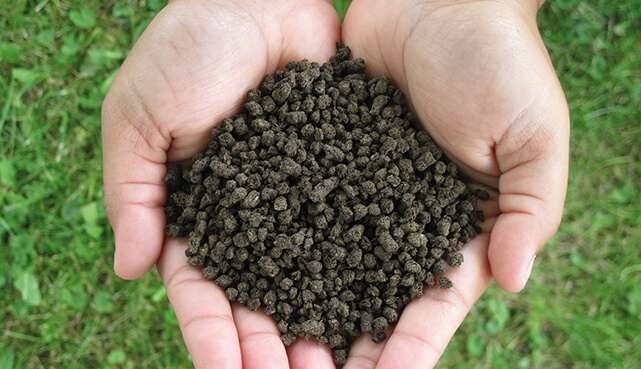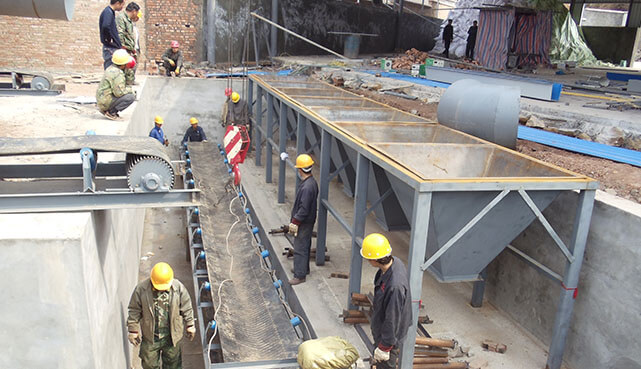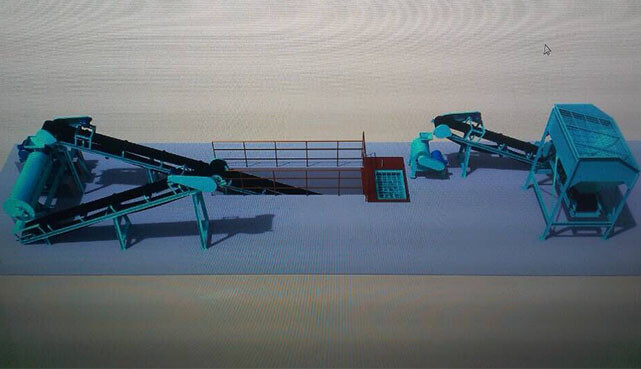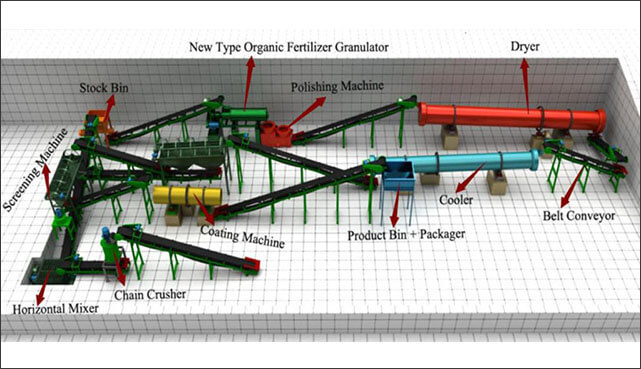Organic fertilizer is derived from plants or animals, which provides nutrients for planting growth after applying to soil. Using physical, chemical and biological technology, eliminate the offending material by certain processing technology, to meet harmless standard. Generally speaking, there are abundant raw materials of organic fertilizer, including cattle manure, crop straws, sludge, compost, microorganisms, etc. Organic fertilizer contains rich organic matters, e.g., organic acid, peptide material, macro-nutrient, secondary element and micro-element. It provides general nutrition for crops, which has advantages of increasing soil organic matters, promoting microorganism reproduction and soil properties.
Classification of Organic Fertilizer
☑ Farm Yard Manure
Farm yard manure is a mixture of animal manure, urine, fodder materials, waste straw and other materials. It contains 0.5% nitrogen, 0.45% iron, 0.25% phosphorus, 0.4% potassium, 0.08% calcium, etc. It is essential in soil amendment and has high content of organic matters.
Nutritional status of FYM (%)
|
Nitrogen
|
Phosphorus
|
Potassium
|
Calcium
|
Sulfur
|
Zinc
|
Copper
|
Manganese
|
Iron
|
|
0.5
|
0.25
|
0.4
|
0.08
|
0.02
|
0.004
|
0.0003
|
0.007
|
0.45
|
☑ Green Manure
Green manure is a fertilizer made from green plants. It is a pure fertilizer which contains complete nutrients. It can be divided into several types, such as cultivation, legumes and aquatic green manure and so on. Planting green manure plays a positive role in increasing fertilizer resource and soil improvement.
☑ Compost
Compost is made from crop straw, leaves, sludge, peat and other plant residue. It requires making a heap of these organic matters and being in process of aerobic fermentation for several weeks or months. Compost Turners, such as hydraulic compost turner, are the most ideal equipment to ferment organic matters!
☑ Biological Organic Fertilizer
Biological organic fertilizer is a fertilizer that used animal and plant waste (such as livestock manure, crop straw)as raw materials and then is handled in harmless treatment. It combines the properties of biological fertilizer and organic fertilizer. Beneficial microorganisms in biological organic fertilizer, after applied to soil, form symbiotic correlation with microbe in soil. It can inhibit the growth of harmful bacteria. These materials can be a complex interaction and mutual promotion. Therefore, it can provide a variety of irritating substances directly or indirectly for crops, to promote and regulate crop growth.
Great Advantages of Investing in Organic Fertilizer Business in United States and Canada
1. Huge organic fertilizer market potential in North America
World fertilizer is developing toward to multi-component, multi-function, high efficiency, high concentration and NO-POLLUTION. It is wise to combine inorganic with organic and microbial organic fertilizer. The organic fertilizer business is relatively new, highly fragmented, under-capitalized and growing rapidly.
1.1 organic fertilizer market is driven by the increasing demand of organic food
The rapid development of the organic agriculture and enhancing demand for organic food in the country spurs the growth of the organic fertilizers market.
Organic food, also called biological food or ecological food, is a product produced in a way that meets international or national organic food requirements and standards. These products should be authenticated by certification body, including grain, edible oil, mushrooms, vegetables, fruit, fruits, nuts, dairy products, poultry livestock products, honey, seafood, spices and so on.

From 2004-2014, organic sales in U.S. increased from 10 billion dollars to 39 billion dollars. Consumers’ demand of organic food has been in sustained growth. As a recent Consumer Reports shown, over 50% consumers in America are willing to buy organic food. Although organic food is continuously increasing, supply shortage is an urgent issue that needs to be solved in future. Nowadays, organic food accounts for 5 percent of total food sales in America. And it will be increasing in recent years.
Organic food sales have been growing steadily from 2000 to 2014. Although organic food sales were in slow growth in 2007-09 recession, it rebounded quickly in the later several years. In 2013-14, it maintains an annual average rate of 11%, which will continue to increase. Therefore, it has huge market potential in organic market in America.
* Canada
Consumers have strong demand for organic food in Canada. Organic food sales increased from 2 billion dollars in 2008 to 3 billion dollars in 2012. Canadian organic food market share has increased nearly triple in value. It was far greater than other agricultural product. More than 58% Canadians are in fond of purchasing organic food according to a survey. Although organic food sales only have a 1.7% market share of the whole food market, it is still increasing year by year. As for OVCRT, it has a goal to spread organic food market share in Canada to 5% by 2018.
Organic farming in North America has been in rapid growth in the past years and is well expanding for continued years. In the process of propelling organic farming, the promoter action of organic fertilizer becomes a hot topic.
1.2 North Americans have already realized the Benefits of Organic Fertilizer
Chemical fertilizers are not environmentally friendly.
Though chemical fertilizers help crops grow, they do not help to improve the health or structure of the soil. Hence, when chemical fertilizers are used for prolonged duration, the soil gets damaged as the trace nutrients are not replenished in the soil, which is the reason why more and more farmers in United States and Canada prefer to use organic fertilizer. In addition, it shows the trend of increasing organic fertilizer market share in agricultural market.
Compared to chemical fertilizer, organic fertilizer has several benefits.
First of all, it can be free of unhealthy materials for agriculture and provide green and organic products.
In the meanwhile, organic fertilizer ensures soil availability for long time and provides multiple nutrients for crops.
At last, organic fertilizer can be produced by farmers or prepared by farm. The cost of organic fertilizer production can be lower than chemical fertilizer.
1.3 large market share of organic fertilizer in North America
U.S. is the second largest fertilizer consumer and leading fertilizer importer in the world. U.S. imports fertilizer mainly from Canada, Mexico and Peru. In 2011, US organic fertilizer market volume is 684.1 million dollars, increasing at an annual average of 20.2%. In the meanwhile, organic fertilizer manufacturers produce fertilizer in certain regions. Organic fertilizer is usually applied to landscaping and gardens in the country. Data shows that, there has already been more than 9,000 organic fertilizer manufacturing factories in United States till 2009, and the number still keeps growing. The consumption of organic fertilizer accounts for 50% of the total fertilizer consumption. Looking across the world organic fertilizer industry, United States takes a large share of the global organic fertilizer–about 80%, the annual profits reaching to 7 billion dollars!
In Canada, it has approximately 2% cultivated land. Because of ever-increasing organic market in the country, it shows growing demand of organic fertilizer. In addition, booming organic food market is the most important factor that drives organic fertilizer market.
2. Abundant & Adequate Raw Materials
Wide Raw Material Sources in North America
Organic fertilizer raw materials can draw on a vast range of different sources.
※ Planting waste: crop straw, weeds, lither, melon vine, etc.
※ Animal farming waste: livestock manure
※ Processing industry waste: bran, meal, sawdust, furfural residue, lees, bagasse, waste wood, etc.
※ Resident sanitary waste: human dung, urban and rural domestic refuse
2.1 Agricultural waste
Nowadays, North America agriculture has been developed into mechanization, commercialization and specialization. Agriculture is a major industry in both U.S. and Canada. In addition, Canada is one of the largest agricultural producers and exporters around the world.
Highly developed agriculture in North America provides endless quality organic raw materials for organic fertilizer production. It is estimated by USDA & DOE that, the net weight of the biomass feedstock from agriculture reaches to nearly 1 billion tons every year, among which crop stalk is 428 million tons.
Crop straws can lead to an increase in water holding capacity of the soil, prevent soil erosion, reduce chemical fertilizer use, and promote the increase of organic matter and N, P, K content in the soil. Taking wheat straw and rice straw for example,
Wheat straw contains roughly the following N-P-K concentration
|
N
|
0.65%
|
|
P2O5
|
0.23%
|
|
K2O
|
1.54%
|
As a guide, a ton of wheat straw normally contains 9 to 12 pounds of nitrogen (N), 3 to 4 pounds of phosphorous (P) in the form of P2O5, and 25 to 45 pounds of potassium (K) in the form of K2O.
Rice Straw is the only organic material available in significant quantities to most rice farmers. About 40 percent of the nitrogen (N), 30-35 percent of the phosphorus (P), 80-85 percent of the potassium (K), and 40-0 percent of the sulfur (S) taken up by rice remains in vegetative plant parts at crop maturity.
Nutrient content of rice straw and amounts removed with 1 ton of straw residue
|
N
|
N
|
P2O5
|
K2O
|
S Si
|
|
|
Content in straw, % dry matter
|
0.5-0.8
|
0.16-2.7
|
1.4-2.0
|
0.05-0.10
|
4-7
|
|
Removed with 1 ton straw, kg/ha
|
5-8
|
1.6-2.7
|
14-20
|
0.5-0.1
|
40-70
|
2.2 Animal waste
Animal manure can be an asset rather than a liability for producers when effectively managed and properly used on field crops. It is good raw materials for organic fertilizer production. Besides providing valuable macro- and micro- nutrients to the soil, manure supplies organic matter to improve the soil’s physical and chemical properties. It also increases infiltration of water and enhances retention of nutrients,reduces wind and water erosion, and promotes growth of beneficial organisms.
The most recent available Census of Agriculture data shows that there were almost 95.5 million cows and calves in the United States in 2002. There were also about 60.4 million hogs and pigs, each producing waste every day. The USDA estimates that more than 335 million tons of “dry matter” waste (the portion of waste remaining after water is removed) is produced annually on farms in the United States, representing almost a third of the total municipal and industrial waste produced every year.
Each year in Oklahoma, an estimated 10 million tons of waste produced by animals in confinement is available for use as fertilizer. Various nutrients contained in animal manure making it become the ideal organic raw materials for bio / organic fertilizer manufacturing!
The approximate fertilizer nutrient content for various manures
|
Manure Type
|
Dry Matter
|
Total N
|
P2O5
|
K2O
|
|
%
|
Ibs./ton
|
|||
|
Feedlot Manure
|
62
|
24
|
21
|
25
|
|
Broiler Litter
|
77
|
63
|
61
|
50
|
|
Ibs./1000gal
|
||||
|
Lagoon Effluent
|
0.5
|
4.2
|
1.0
|
5.0
|
|
Lagoon Sludge
|
7
|
15
|
16
|
11
|
|
Dairy Slurry
|
3
|
13
|
11
|
11
|
2.2.1 Chicken Manure
Data showed that the chicken manure contained 22.34% crude protein, 2.44% crude fat, 10.72% crude fiber, 31.03% crude ash, 10.00% calcium and 2.36% phosphorus. The crude protein content in chicken manure was higher than that in plant livestock feed, and it was 2.23 times as high as that in corn.
2.2.2 Swine Manure
Swine manure contains all 13 of the essential plant nutrients that are used by plants. These
include nitrogen (N), phosphorous (P), potassium (K), calcium (Ca), magnesium (Mg), sulfur
(S), manganese (Mn), copper (Cu), zinc (Zn), chlorine (Cl), boron (B), iron (Fe), and
molybdenum (Mo).
Except for agricultural waste and animal waste, food waste also accounts for a certain proportion of the organic fertilizer raw materials. Consumers in North America and Europe waste about 209 to 253 pounds of food per person every year. In America, there are 33 million tons of food waste each year. Fertilizer made from food waste reduce air and water pollution, and improve soil quality.
3. Advanced Organic Fertilizer Manufacturing Technology
In some developing countries, organic fertilizer production technology may be relatively backward. Organic fertilizer production is processing in humble place. There is no large equipment and workshop. For example, animal bone or leaves are only burning. And then it can be used for organic fertilizer directly. Commercial organic fertilizer cannot find in these countries.
In North America region, Commercial organic fertilizer production can be divided into several processes, including compost stage (hydraulic compost turner), raw material crushing (fertilizer crusher), material mixing (fertilizer mixer), fertilizer granulation (organic fertilizer granulator), fertilizer drying and cooling (fertilizer dryer and cooler), fertilizer packaging (automatic fertilizer packager). Of course, in the production of organic fertilizer, some accessory equipment can be used in this production, such as organic fertilizer coating machine, fertilizer polishing machine, belt conveyor, etc. See more organic fertilizer making machines.
The origin of North American organic fertilizer production is early. It develops into the direction to bio organic fertilizer and organic compound fertilizer. Commercial organic fertilizer appears in many years. In the meanwhile, this kind of organic fertilizer has high fertilizer efficiency. Farmer are willing to use the organic fertilizer to their farm land.
4. Promising Future of Organic Fertilizer in North America
Compared to chemical fertilizer, organic fertilizer production has low investment and high benefit.
Global organic product market is increasing at the rate of 20-30% annually. Using chemical fertilizer in long terms brings about many side effects. It is the urgent need to use organic fertilizer with high efficiency and high quality to meet the needs of agriculture production. Organic fertilizer contains many organic matters and trace elements. If farmers apply 2,000 tonnes organic fertilizer into soil, it can reduce chemical fertilizer usage for 4,000 tonnes. Centralized treatment of organic fertilizer raw material avoids harm to environment. Moreover, it is a mutual project to organic fertilizer manufacturers and farmers. At the same time, organic fertilizer production investment increases industrial chain. It is helpful for organic fertilizer manufacturers to gain significant economic benefits and make big and strong.
Moreover, North America agriculture is developing to organic farming, promoting organic fertilizer market development. Organic fertilizer commercialization is an irresistible trend of modern agriculture. Based on booming organic farming and organic food market, organic fertilizer production will be developed in a rapid growth. In the meanwhile, organic fertilizer market share will increase continuously. Organic fertilizer provides multiple nutrients and improves soil properties, which is good for organic farming.
With the increase of organic fertilizer imports and exports in North America, organic fertilizer market shows positive trend. In addition, increasing organic food in U.S. and Canada drives organic fertilizer development. People’s demand on organic food increase year by year, but organic food production yield remains to be increase. In the meanwhile, organic fertilizer benefit is in increasingly trend, farmers prone to use organic fertilizer in their land. What’s more, organic fertilizer production technology is mature and advanced, which provides favorable condition for people who are interested in organic fertilizer business. And there are a lot of organizations are promoting organic farming. It is also a good factor that actives organic fertilizer market.
Investing organic fertilizer production is a good choice, not just because it has wide range of raw material and is easy to get. Now that it has sound foundation of agriculture, the use of fertilizer is necessary for farmers. The more organic farming is, the more demand of organic fertilizer is. One of the most important factor to be engaged in organic fertilizer production is that it has high profit. According to a survey, it only needs two years for a factory to recovery cost. It is obvious to everyone that organic fertilizer has numerous benefits to soil and plants. Therefore, organic fertilizer investment can be an feasible project in North America.









